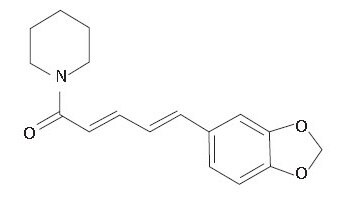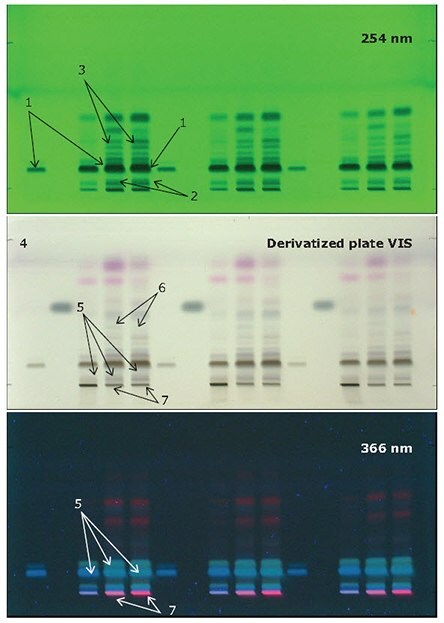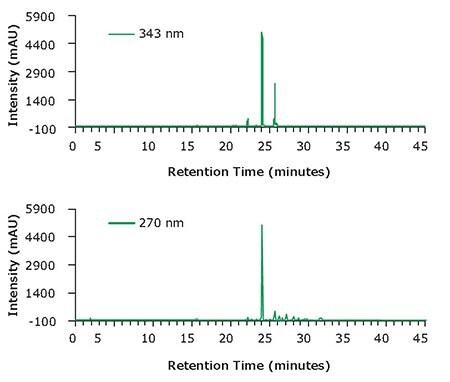Chromatographic Testing of Black Pepper
Anita Piper, Markus Burholt, Stephan Altmaier, Michael Schulz, Patrik Appelblad
Introduction
In truth, what are dietary supplements? They are consumed in large quantities, and are often referred to as vitamins, minerals or even botanicals derived from plants. A dietary supplement is intended to provide nutrients that may otherwise not be consumed in sufficient quantities. Black pepper, a common spice, is also regarded as a dietary supplement and a source of piperine (Figure 1).

Figure 1. Piperine structure.
Usually when an analytical method is developed, the sample is the focal point of the analysis, driving the consumables or accessories needed, and the optimum sample preparation method to analyze the sample and produce reliable results. In other words, decisions are dictated by the sample. In pharmaceutical control, the methodology is regulated by different pharmacopeial bodies, such as the United States, British, European, Chinese and Japanese Pharmacopeias, who establish and update official monograph methods.
With a regulated method, one must follow the monograph instead of just putting the sample at the center of the decision making, so it is purely following the instructions in the monograph. One must know how to apply the dictated product specifications in the methods to get to the point where the value of interest can be reported. There is clearly defined information on what can be changed, the system suitability criteria to meet and how the method should be validated.
In this article, we have chosen powdered black pepper as an example, and have tested it according to the current United States Pharmacopeia (USP) guidelines.
Monograph for Black Pepper Extract
The monograph from USP40-NF35 for powdered black pepper extract has a section dedicated to its identification, and another section which outlines its composition analysis. Powdered black pepper is defined as black pepper reduced to powder or very fine powder. It contains not less than (NLT) 2.5% of piperine, calculated on the dried basis. Under the identification test, it refers to a specific method related to its botanical characteristics, which requires high performance thin layer chromatography (HPTLC). The section on compositional analysis refers to high performance liquid chromatography (HPLC).
Identification Using HPTLC
The monograph specifies a chromatographic silica gel mixture with an average particle size of 5 μm (HPTLC plates), and the mobile phase as a mixture of hexane and ethyl acetate with a volume ratio (v/v) of 5:3. The sample solutions are applied as bands with a bandwidth of 8 mm, using a migration distance of 6 cm. Tracks that were applied to the HPTLC plate are (from left to right):
- Track 1: 3 μL standard solution A, USP reference standard (RS) of 0.9 mg/mL piperine in methanol.
- Track 2: 3 μL standard solution B, a 2 mg/mL borneol standard in methanol.
- Track 3: 15 μL standard solution C, USP powdered black pepper extract RS 5 mg/mL in methanol, sonicated, centrifuged, and the supernatant is used.
- Track 4 & 5: 7 μL two different commercial pepper samples of the same concentration taken through the same sample preparation steps. (add about 0.5 g of powdered black pepper to 5 mL of methanol, sonicate for 10 minutes, and then use the supernatant).
The resulting HPTLC plate is shown in Figure 2.
The conditions & acceptance criteria, i.e., requirements for characterization for black pepper extracts according the HPTLC test in the USP monograph, are identified below:

Figure 2. Identification of powdered black pepper by HPTLC as described in USP40-NF35.
UV analysis at 254 nm
Use a saturated chamber, and condition the plate to a relative humidity of about 33% using a suitable device. Develop the plate until the solvent front has moved up about 7 cm from the lower edge of the plate. Remove the plate from the chamber, dry, and examine under UV light at 254 nm.
- Under 254 nm, the chromatogram of the sample solution exhibits an intense band at a RF (retention factor) of about 0.15 corresponding to the piperine band in the chromatogram of standard solution A (Track 1)
- A band at RF of about 0.02
- Three bands of similar intensity equally spaced located between RF of about 0.3 and 0.5
Derivatized Plate VIS & UV 365 nm
Treat the HPTLC plate with derivatization solution (17 mL of ice-cooled methanol, 2 mL of acetic acid, 1 mL of sulfuric acid, and 0.1 mL of anisaldehyde, mixed in this order), heat for 5 minutes at 100 °C, and examine under white light.
Under white light, the derivatized chromatogram of the sample solution exhibits main bands similar in position and color to the main bands in the chromatogram of standard solution C.
- These bands include a dark green band of the same color and RF as the piperine band in standard solution (RF of about 0.15).
- A weak violet band at RF of about 0.47 below the position of the band due to borneol in standard solution B.
- A greenish band (in Figure 2 it is actually pink) in the lower part of the chromatogram at RF of about 0.07.
It is worth pointing out that other minor bands may be observed in the sample solution and standard solution C chromatograms. No blue bands are detected in the chromatogram of the sample solution at hRF of about 10 and 58 (distinctive from longer pepper). Using the previously mentioned HPTLC plates (glass plate Si 60 F254, 20 x 10 cm, like Cat. No. 1.05642) and following the prescribed recipe in the USP monograph, the acceptance criteria for black pepper under the identification test by HPTLC can be met.
Compositional Analysis by HPLC
The HPLC compositional test described in the monograph, a gradient method, is defining a 4.6 mm x 25 cm, 5 μm, 100 A packing L1 (C18) column. In this study we illustrate that the method system suitability criteria can be met by using a Purospher® STAR, 250 x 4.6 mm, 5 μm, RP-18 endcapped column.
Solution A, or mobile phase A, is a mix of anhydrous potassium dihydrogen phosphate (0.14 g) in 1000 mL of Milli-Q® water incl. 0.5 mL phosphoric acid, while solution B is gradient grade acetonitrile. The gradient profile is shown in Table 1. For gradient methods it is important that the column is sufficiently re-equilibrated to obtain good reproducibility. There are several approaches to express the required volume for column re-equilibration. With a flow rate of 1.5 mL/min, an empty tube volume of about 4.2 mL (250 x 4.6 mm column geometry), re-equilibrating is ensured by flushing the column for about 20 minutes or with 30 mL of solvent corresponding to seven complete empty column tube volumes. It can also be expressed in terms of the free/void column volume (depending on packing density and material porosity), which is estimated with 0.1 mL/cm for 4.6 mm ID columns resulting in a „free“ column/solvent volume of 2.5 mL for a 25 cm column. 30 mL solvent thus corresponds to 12 free column volumes. The key is to make sure to flush the column sufficiently to ensure reproducibility.
The sample preparation was done as follows: Black pepper powder (about 2.0 g) was put into a 250 mL flask with a condenser and refluxed with 50 mL HPLC grade methanol for 20 minutes (repeated until last extract was colorless, after which the extracts were combined and concentrated under vacuum). The final sample volume was adjusted to 100 mL with methanol, and filtered through a 0.45 μm Millex® PVDF membrane filter, before being introduced into the HPLC system. The system suitability was determined using standard solution A (0.1 mg/mL of USP Piperine RS in methanol) and standard solution B (about 0.5 mg/mL USP powdered black pepper extract RS sonicated, filtered and reconstituted in methanol). Acceptance criteria for the method is defined by the piperine peak tailing factor to be not more than (NMT) 1.5 when analyzing solution A.
Additionally the sample solution chromatogram obtained at 343 nm should exhibit a major peak at the retention time corresponding to piperine (Figure 3). The identification of other piperamide peaks in the sample solution was confirmed by comparing with the standard solution B and the reference chromatogram provided with the lot of USP powdered black pepper extract reference standard. The sample solution chromatogram at 343 nm wavelength shows an additional peak corresponding to piperylene. The chromatogram of the sample solution obtained at 270 nm does not exhibit a peak due to (2E,4E)-N-isobutyldecadienamide at a relative retention time of 1.14 to the piperine peak (distinction from long pepper) (Table 2). Comparing calibration curves for piperine at the two different wavelengths, the 343 nm gives slightly poorer limits of detection (LOD) and quantitation (LOQ) compared to the 270 nm wavelength (data not shown), but both provide an LOD better than 10 ppm.

Figure 3. Chromatogram
Conclusion
Testing dietary supplement products using regulated chromatographic methods requires an understanding of how different products can be used and operated based on the guidelines of the monograph. In this article we demonstrated that by using suitable HPTLC and HPLC media, appropriate filter, high purity solvents and reagents and following the prescribed USP monograph recipe, you can easily meet the system suitability criteria for black pepper.
Materials
To continue reading please sign in or create an account.
Don't Have An Account?